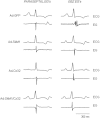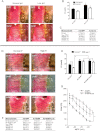SkM1 and Cx32 improve conduction in canine myocardial infarcts yet only SkM1 is antiarrhythmic
- PMID: 22374989
- PMCID: PMC3410408
- DOI: 10.1093/cvr/cvs107
SkM1 and Cx32 improve conduction in canine myocardial infarcts yet only SkM1 is antiarrhythmic
Abstract
Aims: Reentry accounts for most life-threatening arrhythmias, complicating myocardial infarction, and therapies that consistently prevent reentry from occurring are lacking. In this study, we compare antiarrhythmic effects of gene transfer of green fluorescent protein (GFP; sham), the skeletal muscle sodium channel (SkM1), the liver-specific connexin (Cx32), and SkM1/Cx32 in the subacute canine infarct.
Methods and results: Immediately after ligation of the left anterior descending artery, viral constructs were implanted in the epicardial border zone (EBZ). Five to 7 days later, efficient restoration of impulse propagation (narrow QRS and local electrogram duration) occurred in SkM1, Cx32, and SkM1/Cx32 groups (P< 0.05 vs. GFP). Programmed electrical stimulation from the EBZ induced sustained ventricular tachycardia (VT)/ventricular fibrillation (VF) in 15/22 GFP dogs vs. 2/12 SkM1, 6/14 Cx32, and 8/10 SkM1/Cx32 (P< 0.05 SkM1 vs. GFP). GFP, SkM1, and SkM1/Cx32 had predominantly polymorphic VT/VF, whereas in Cx32 dogs, monomorphic VT predominated (P< 0.05 for Cx32 vs. GFP). Tetrazolium red staining showed significantly larger infarcts in Cx32- vs. GFP-treated animals (P< 0.05).
Conclusion: Whereas SkM1 gene transfer reduces the incidence of inducible VT/VF, Cx32 therapy to improve gap junctional conductance results in larger infarct size, a different VT morphology, and no antiarrhythmic efficacy.
Figures






Similar articles
-
Effect of skeletal muscle Na(+) channel delivered via a cell platform on cardiac conduction and arrhythmia induction.Circ Arrhythm Electrophysiol. 2012 Aug 1;5(4):831-40. doi: 10.1161/CIRCEP.111.969907. Epub 2012 Jun 21. Circ Arrhythm Electrophysiol. 2012. PMID: 22722661 Free PMC article.
-
Epicardial border zone overexpression of skeletal muscle sodium channel SkM1 normalizes activation, preserves conduction, and suppresses ventricular arrhythmia: an in silico, in vivo, in vitro study.Circulation. 2009 Jan 6;119(1):19-27. doi: 10.1161/CIRCULATIONAHA.108.809301. Epub 2008 Dec 22. Circulation. 2009. PMID: 19103989 Free PMC article.
-
Expression of skeletal muscle sodium channel (Nav1.4) or connexin32 prevents reperfusion arrhythmias in murine heart.Cardiovasc Res. 2011 Jan 1;89(1):41-50. doi: 10.1093/cvr/cvq284. Epub 2010 Sep 7. Cardiovasc Res. 2011. PMID: 20823275 Free PMC article.
-
Myocardial gap junctions: targets for novel approaches in the prevention of life-threatening cardiac arrhythmias.Physiol Res. 2008;57 Suppl 2:S1-S13. doi: 10.33549/physiolres.931546. Epub 2008 Mar 28. Physiol Res. 2008. PMID: 18373398 Review.
-
Rationale of therapy in the patient with acute myocardial infarction and life-threatening arrhythmias: a focus on bretylium.Am J Cardiol. 1984 Jul 30;54(2):14A-19A. doi: 10.1016/0002-9149(84)90812-9. Am J Cardiol. 1984. PMID: 6380259 Review.
Cited by
-
Can heart function lost to disease be regenerated by therapeutic targeting of cardiac scar tissue?Semin Cell Dev Biol. 2016 Oct;58:41-54. doi: 10.1016/j.semcdb.2016.05.020. Epub 2016 May 24. Semin Cell Dev Biol. 2016. PMID: 27234380 Free PMC article. Review.
-
Restoring heart function and electrical integrity: closing the circuit.NPJ Regen Med. 2017 Apr 7;2:9. doi: 10.1038/s41536-017-0015-2. eCollection 2017. NPJ Regen Med. 2017. PMID: 29302345 Free PMC article. Review.
-
SCN10A-short gene therapy to restore conduction and protect against malignant cardiac arrhythmias.Eur Heart J. 2025 May 7;46(18):1747-1762. doi: 10.1093/eurheartj/ehaf053. Eur Heart J. 2025. PMID: 39973098 Free PMC article.
-
Modelling the interaction between stem cells derived cardiomyocytes patches and host myocardium to aid non-arrhythmic engineered heart tissue design.PLoS Comput Biol. 2022 Apr 1;18(4):e1010030. doi: 10.1371/journal.pcbi.1010030. eCollection 2022 Apr. PLoS Comput Biol. 2022. PMID: 35363778 Free PMC article.
-
Deranged sodium to sudden death.J Physiol. 2015 Mar 15;593(6):1331-45. doi: 10.1113/jphysiol.2014.281204. J Physiol. 2015. PMID: 25772289 Free PMC article. Review.
References
-
- Allessie MA, Boyden PA, Camm AJ, Kleber AG, Lab MJ, Legato MJ, et al. Pathophysiology and prevention of atrial fibrillation. Circulation. 2001;103:769–777. - PubMed
-
- Wit AL, Janse MJ. Experimental models of ventricular tachycardia and fibrillation caused by ischemia and infarction. Circulation. 1992;85:I32–I42. - PubMed
-
- Janse MJ, Wit AL. Electrophysiological mechanisms of ventricular arrhythmias resulting from myocardial ischemia and infarction. Physiol Rev. 1989;69:1049–1169. - PubMed
-
- Hennan JK, Swillo RE, Morgan GA, Keith JC, Jr, Schaub RG, Smith RP, et al. Rotigaptide (zp123) prevents spontaneous ventricular arrhythmias and reduces infarct size during myocardial ischemia/reperfusion injury in open-chest dogs. J Pharmacol Exp Ther. 2006;317:236–243. doi:10.1124/jpet.105.096933. - DOI - PubMed
-
- Macia E, Dolmatova E, Cabo C, Sosinsky AZ, Dun W, Coromilas J, et al. Characterization of gap junction remodeling in epicardial border zone of healing canine infarcts and electrophysiological effects of partial reversal by rotigaptide. Circ Arrhythm Electrophysiol. 2011;4:344–351. doi:10.1161/CIRCEP.110.959312. - DOI - PMC - PubMed
Publication types
MeSH terms
Substances
Grants and funding
LinkOut - more resources
Full Text Sources
Medical
Miscellaneous

